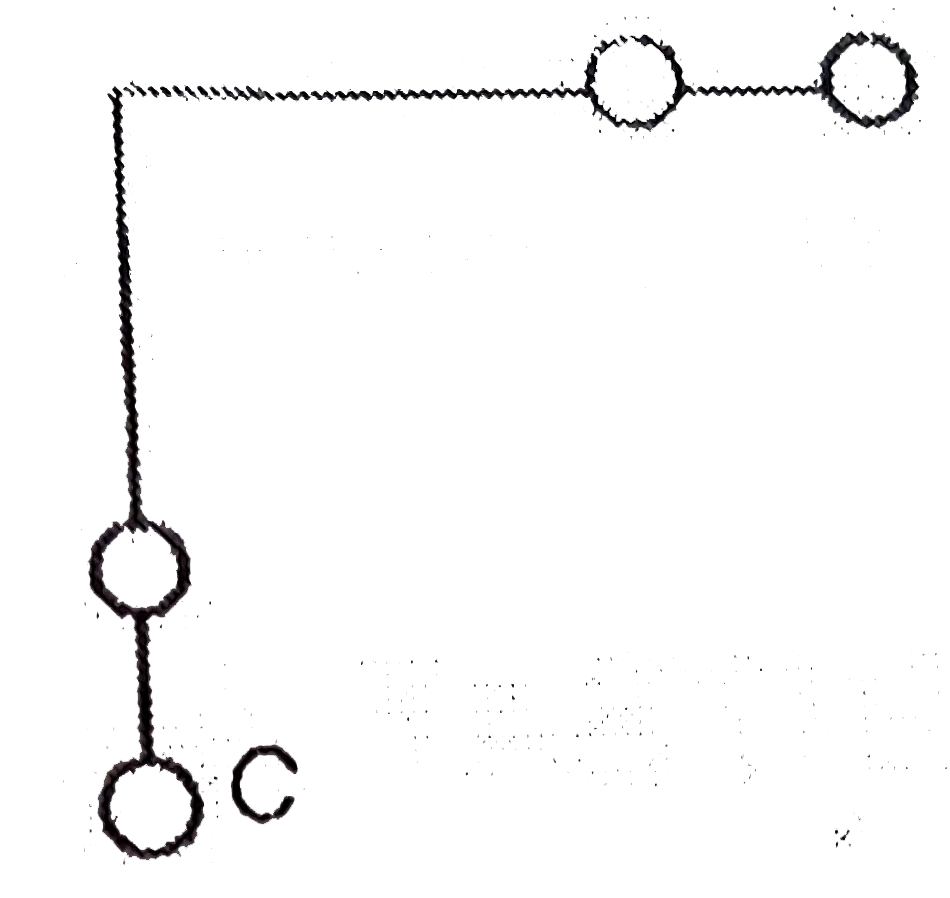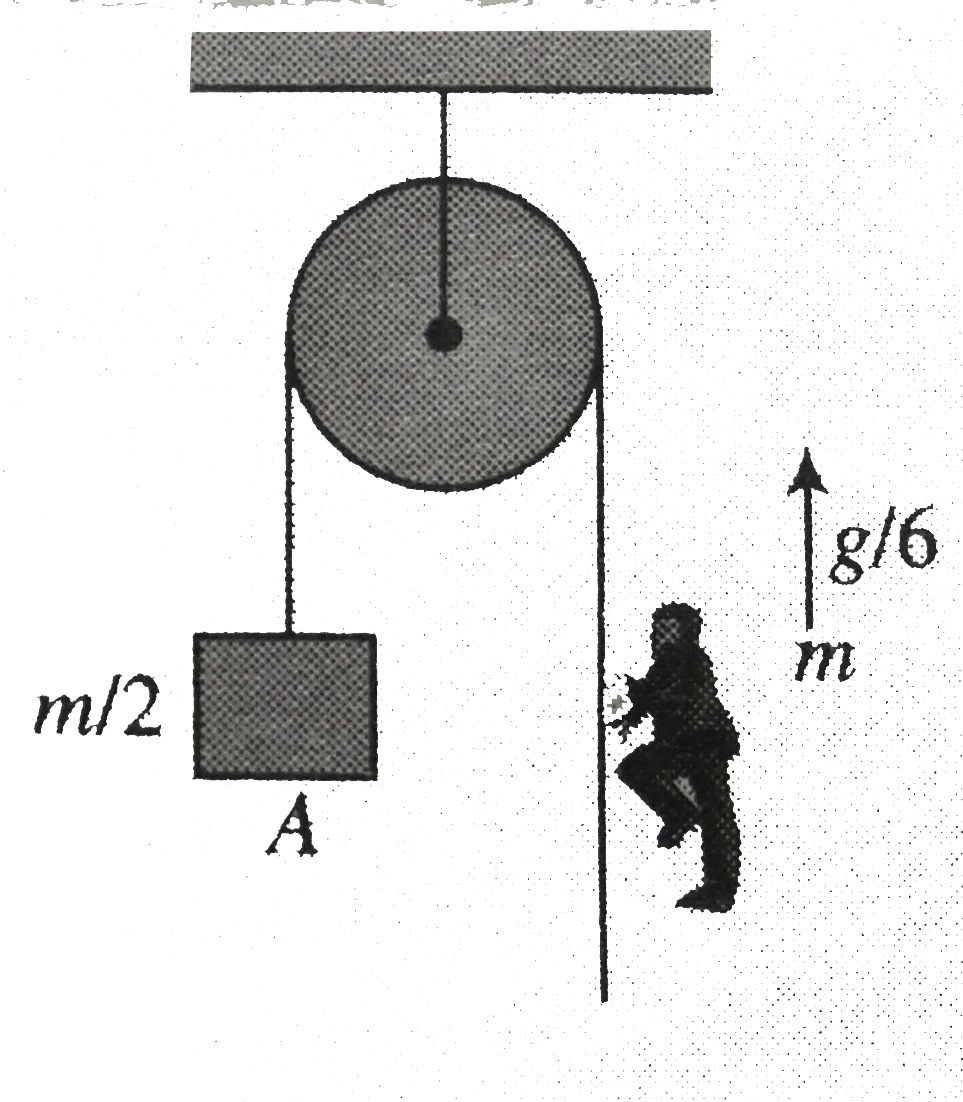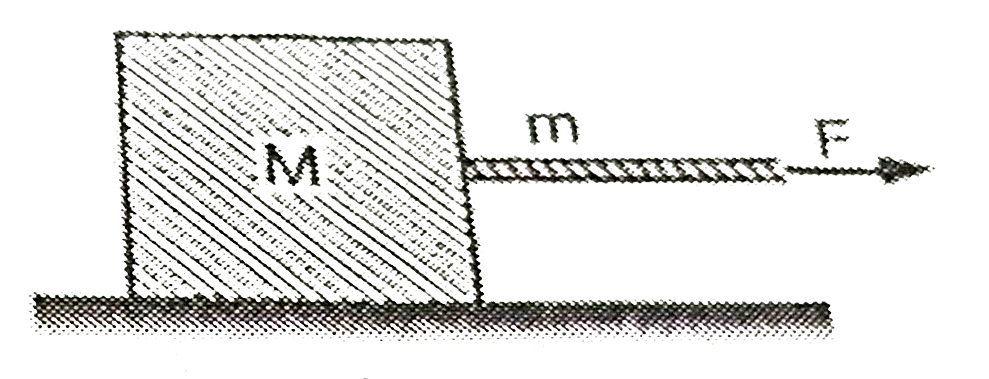Two particles of equal mass are connected to a rope AB of negligible mass, such that one is at end A and the other dividing the length of the rope in the ratio 1:2 from A.The rope is rotated about end B is a horizontal plane. Ratio of the tensions in the smaller part to the other is (ignore effect of gravity)
5:3
1:4
1:2
1:3
The correct Answer is:D
To solve the problem, we need to analyze the system of two particles connected by a rope and rotating about a fixed point. We will denote the mass of each particle as m and the total length of the rope as L. The two particles are positioned such that one is at point A and the other divides the length of the rope in the ratio 1:2 from A.
1. Identify the Lengths:
- Let the total length of the rope AB=L.
- The first particle at point A is at distance 0 from A.
- The second particle divides the rope in the ratio 1:2, so it is located at L3 from A and 2L3 from B.
2. Determine the Radius of Rotation:
- The radius of rotation for the particle at A is rA=L.
- The radius of rotation for the particle at the second position (let's call it P) is rP=2L3.
3. Centrifugal Force Calculation:
- The centrifugal force acting on the particle at A is given by:
FA=mω2rA=mω2L
- The centrifugal force acting on the particle at P is given by:
FP=mω2rP=mω2(2L3)=23mω2L
4. Tension Calculation:
- For the particle at A, the tension T2 is equal to the centrifugal force:
T2=mω2L
- For the particle at P, the tension T1 must balance the centrifugal force acting on it and the tension in the rope:
T1=T2+FP
Substituting the values:
T1=mω2L+23mω2L=mω2L(1+23)=mω2L⋅53
5. Ratio of Tensions:
- Now, we can find the ratio of the tensions T1T2:
T1T2=53mω2Lmω2L=53
Final Answer:
The ratio of the tensions in the smaller part to the other is 53.
- Let the total length of the rope AB=L.
- The first particle at point A is at distance 0 from A.
- The second particle divides the rope in the ratio 1:2, so it is located at L3 from A and 2L3 from B.
- The radius of rotation for the particle at A is rA=L.
- The radius of rotation for the particle at the second position (let's call it P) is rP=2L3.
- The centrifugal force acting on the particle at A is given by:
FA=mω2rA=mω2L
- The centrifugal force acting on the particle at P is given by:
FP=mω2rP=mω2(2L3)=23mω2L
- For the particle at A, the tension T2 is equal to the centrifugal force:
T2=mω2L
- For the particle at P, the tension T1 must balance the centrifugal force acting on it and the tension in the rope:
T1=T2+FP
Substituting the values:
T1=mω2L+23mω2L=mω2L(1+23)=mω2L⋅53
- Now, we can find the ratio of the tensions T1T2:
T1T2=53mω2Lmω2L=53
The ratio of the tensions in the smaller part to the other is 53.
Topper's Solved these Questions
- LAWS OF MOTIONBOOK - DC PANDEY ENGLISHCHAPTER - LAWS OF MOTIONEXERCISE - Check point 5.3
20 Videos
- LAWS OF MOTIONBOOK - DC PANDEY ENGLISHCHAPTER - LAWS OF MOTIONEXERCISE - Check point 5.4
20 Videos
- LAWS OF MOTIONBOOK - DC PANDEY ENGLISHCHAPTER - LAWS OF MOTIONEXERCISE - Check point 5.1
20 Videos
- KINEMATICS 1BOOK - DC PANDEY ENGLISHCHAPTER - KINEMATICS 1EXERCISE - INTEGER_TYPE
15 Videos
- LAWS OF THERMODYNAMICSBOOK - DC PANDEY ENGLISHCHAPTER - LAWS OF THERMODYNAMICSEXERCISE - Level 2 Subjective
18 Videos
Similar Questions
Two particles of masses m1andm2 are connected to a string and the system is rotated in a horizontal plane with 'P' as center. The ratio of tension in the two parts of string is

View SolutionTwo particles of mass m each are attached to a light rod of length d, one at its centre and the other at a free end, The rod is fixed at the other end and is rotated in a plane at an angular speed ω. Calculate the angular momentum of the particle at the end with respect to the particle at the centre
View SolutionIf two charged particles each of charge q mass m are connected to the ends of a rigid massless rod and is rotated about an axis passing through the centre and ⊥ to length. Then find the ratio of magnetic moment to angular momentum
View SolutionA cart of mass M is tied to one end of a massless rope of length 10m. The other end of the rope is in the hands of a man of mass M. The entire system is on a smooth horizontal surface. The man is at x=0 and the cart at x=10m. If the man pulls the cart by the rope, the man and the cart will meet at the point
View SolutionA cart of mass M is tied to one end of a massless rope of length 10m. The other end of the rope is in the hands of a man of mass M2. The entire ststem is on a smooth horizontal surface. If the man pulls the cart by the rope then find the distance by which the man will slip on the horizontal surface before the man and the cart will meet each other.
View SolutionA weightless rod of length l carries two equal masses m one fixed at the end and other in the middle ofhte rod. The rod can revolve in a vertical plane about A. Then, horizontal velocity which must be imparted to end C of rod to deflect it to horizontal position is

View SolutionBlock A of mass m/2 is connected to one end of light rope which passes over a pulley as shown in fig. A man of mass m climbs the other end of rope with a relative acceleration of g/6 with respect to rope. Find the acceleration of block A and tension in the rope.

View SolutionA block of mass M is pulled along a horizontal frictionless surface by a rope of mass m as shown in A horizontal force F is applied to one end of the rope. Find
(a) the acceleration of the rope and block
(b) the force that the rope exerts on the block
(c) the tension in the rope at its mid point

View SolutionA light rope is passed over a pulley such that at its one end a block is attached , and on the other end a boy is climbing up with acceleration g2 relative to rope. Mass of the block is 30 kg and that of the boy is 40 kg. Find the tension and acceleration of the rope .
View SolutionA particle of mass 200g is attached to an ideal string of length 1.30 m whose upper end is fixed to ceiling. The particle is made to revolve in a horizontal circle of radius 50 cm. The tension in the string is (g=10ms2)
View Solution
